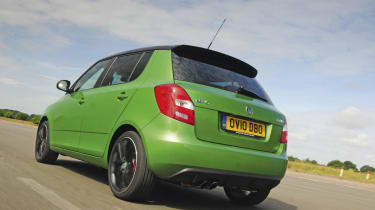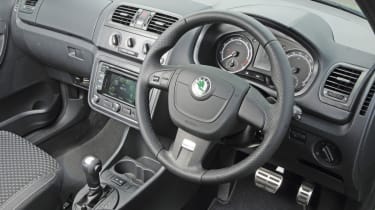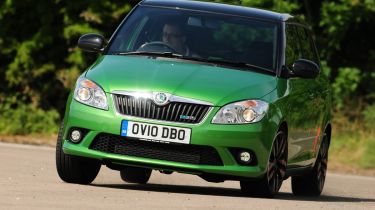Skoda Fabia vRS (2010-2014) review
The Skoda Fabia vRS is a fun, reliable and practical hot hatch, that's powered by a 178bhp 1.4 TSI

The first generation Skoda Fabia vRS was something of a hot hatch trendsetter when it was released with a powerful 1.9-litre TDI diesel engine. It stood out from the hot hatch crowd and has since developed a strong following.
The second generation model ditched the diesel engine when it was introduced, instead featuring the 1.4-litre TSI petrol unit shared with the VW Polo GTI and coupled as standard with a twin-clutch DSG gearbox. This automatic-only set-up has somewhat limited appeal - especially for driving enthusiasts and hot hatch purists who may also be considering the Ford Fiesta ST and Peugeot 208 GTI.
Skoda could be about to upset even more fast Fabia fans, though. With the upcoming release of an all-new Fabia, it has been rumoured that a vRS model won't even feature in the mk3 line-up.
Currently, buyers can opt for five-door hatch or vRS estate versions, should you need some extra space. Putting out 178bhp, the Fabia vRS sprints from 0-62mph in 7.3 seconds and will go on to reach 139mph.
The vRS is beginning to feel its age compared to its rivals. From some angles it looks a little too tall and awkward, but this body shape ensures it's one of the most practical hot hatches you can buy, with room for four and a decent-sized 315-litre boot. The interior is solidly built, as you'd expect being based on the VW Polo, but it's a dull and uninspiring place to be - with only a couple of vRS badges and sports seats to suggest you're in something sporty.
Engines, performance and drive
Powering the Fabia vRS is a 178bhp 1.4-litre TSI engine equipped with a supercharger and turbocharger. This is shared with the VW Polo GTI and SEAT Ibiza Cupra and is only available with a seven-speed twin-clutch transmission. Acceleration is swift enough - taking 7.3 seconds from 0-62mph - but the transmission can be frustrating at times, kicking down ratios when you put your foot down and try to make quick progress.

The chassis delivers reassuring levels of grip, but there's plenty of body movement and the handling and steering are numb. This means the vRS lacks the fun factor of its closest rivals, which is what this type of car is all about. The stability control is a little intrusive, too, while a firm ride takes the edge off comfort on the road.
MPG, CO2 and Running Costs
The Fabia vRS is fairly efficient for a hot hatch, thanks in part to the DSG gearbox and a small engine capacity. On the combined cycle, the Fabia should return 45.6mpg and emits 148g/km of CO2, which is only just behind the more recent Ford Fiesta ST and Peugeot 208 GTI.
Used - available now

2021 Land Rover
Range Rover
27,750 milesAutomaticDiesel3.0L
Cash £49,995
2022 BMW
3 Series Touring
52,456 milesAutomaticDiesel2.0L
Cash £23,800
2018 Mazda
6 Saloon
48,985 milesAutomaticPetrol2.0L
Cash £12,600
2023 Mercedes
EQC
55,207 milesAutomaticElectric
Cash £22,300The Fabia is on a par with the Fiesta ST-1 price-wise, and undercuts the 208 by nearly £1,400. Skoda dealers have a fantastic reputation for customer care, although servicing costs are a little expensive. Insurance costs will be an issue for younger drivers, but the Fabia sits three insurance groups below the Fiesta and 208.
Interior, design and technology
The Fabia isn't a naturally sporty-looking car, with a narrow body and upright stance. Adding a bodykit, larger alloys, smoked headlamps and vRS badges have done little to make it look more dynamic, but the optional black or white wheels and roof go some way to beefing things up. In true hot hatch fashion, the Fabia can be specced with bright green paintwork to shout about its vRS status.
On the inside, there's a leather steering wheel, sports seats, vRS badges and stainless steel pedals - but these do little to brighten up the Fabia's dark and dull cabin. It's an inoffensive place to be and feels well screwed together, but it won't set pulses racing.
Practicality, comfort and boot space
Despite its compact dimensions, the Skoda Fabia is reasonably spacious. Its tall body lends itself well to decent headroom, and the 315-litre boot is good for a small hot hatch. With the rear seats folded, loadspace increases to 1,180 litres and there are plenty of storage cubbies dotted around the cabin.

Should you require more space, but have to have a Fabia vRS, the estate model offers 505 litres of bootspace. An air-conditioned glovebox is standard, and under-seat storage boxes can be specified from the options list. You also have to pay extra if you want electric rear windows and a front armrest.
Reliability and Safety
Skoda has dominated our 2014 Driver Power customer satisfaction surveys for years, coming in first place in 2014, with the Yeti, Citigo and Superb cars occupying the top three places. The Fabia ranked further down the table, though - being criticised for its ride quality and running costs, but owners seem happy with the Fabia's reliability.
However, safety is decent on the Fabia vRS. It comes equipped with front, side and curtain airbags, ISOFIX, stability control and tyre pressure monitoring as standard, but the need to pay for a third rear headrest is disappointing. Euro NCAP tested the standard Fabia and it received a surprising four-stars in its tests because it doesn't offer ESP as standard on entry-level cars.







